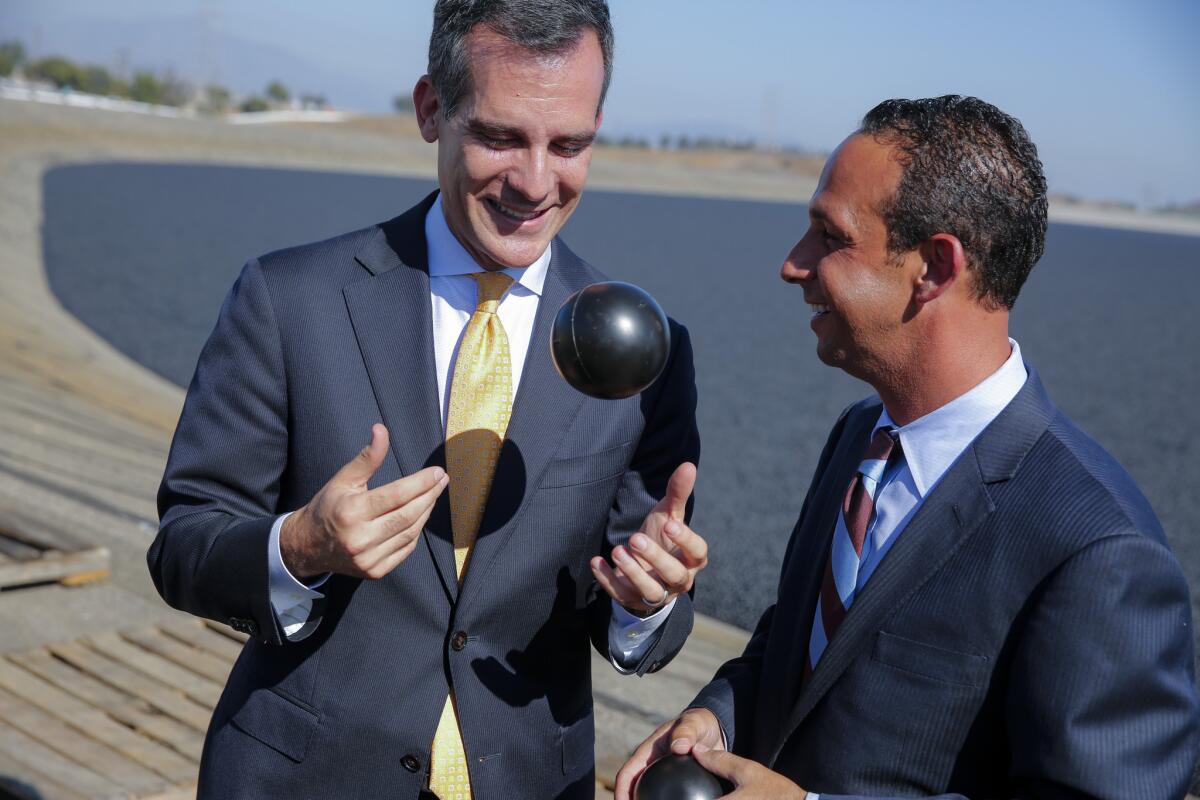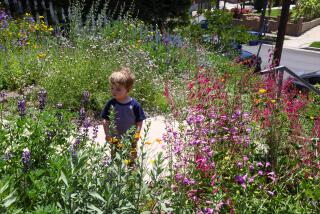First & Spring: L.A.’s shade balls go viral — but the Internet has mixed opinions

While Mayor Eric Garcetti, left, with Councilman Mitchell Englander, touted the city’s release of 20,000 small black balls into the Los Angeles Reservoir as “bold ingenuity.”
- Share via
It started out like a typical photo op when Mayor Eric Garcetti arrived at the Los Angeles Reservoir in Sylmar this month.
He was joined by officials from the city and the Department of Water and Power, who stood on the banks of the Los Angeles Reservoir to unload 20,000 small black balls into the water. The so-called shade balls are designed to form a cover and protect the water from UV rays and algae. They also reduce evaporation, which is important amid California’s drought.
But there was something mesmerizing about all those balls rolling out of the truck and bouncing down into the water. They went seriously viral.
Within hours, videos of the shade balls were everywhere. Social media went crazy for the name. The hashtag #shadeballs took off, with one Twitter user writing, “If you ever doubted that LA was the home to everything plastic... #shadeballs.” And the mayor found a drought angle for the long-standing water quality project.
Water and Power is The Times’ guide to the drought. Sign up to get the free newsletter >>
“In the midst of California’s historic drought, it takes bold ingenuity to maximize my goals for water conservation,” Garcetti said in a statement, noting that the balls would reduce evaporation by as much as 300 million gallons a year.
Shade balls turned into a PR triumph that lasted a while. The story made headlines in publications that typically don’t cover the DWP:
• “California throwing shade ... at the drought” — TMZ
• “Shade balls fill reservoir to conserve water in drought-hit LA” — The Guardian
• “LA throws 96 million ‘shade balls’ at its water shortage — and it’s mesmerizing” — Mashable
Then the shade ball became a true media darling.
A headline in the New York Times declared: “In California, Millions of ‘Shade Balls’ Combat a Nagging Drought.” Video of the rollout posted on the mayor’s Facebook page was shared 21,000 times.
Judy Muller, a broadcast professor at USC’s Annenberg School for Communication and Journalism, first saw the story on a Russian newscast in her hotel room in Moscow.
“Garcetti is no fool when it comes to social media. He knew that this was a new way to get people interested in the drought story,” Muller said. “Whether it’s the bear in the backyard or the shade balls in the reservoir — it’s good video and, I now know, it’s such good video that it made it to Russia.”
But amid the fascination came questions.
The shade balls are made of high-density polyethylene, the same plastic found in 1-gallon containers of milk and even the DWP’s own water pipes. Inside the balls is drinking water, which helps weigh them down so they don’t blow away in a gusty breeze. Carbon black is added to the balls to stabilize them in the sun’s UV rays.
See the most-read stories this hour >>
Those details didn’t seem to connect with viewers and readers, who still had a host of questions after watching the footage of black balls rolling in the water: Why were the balls black? Wouldn’t the plastic contaminate the drinking water? Won’t the balls heat the water and breed bacteria?
Those questions reached a fever pitch last Thursday. In a piece for FoxNews.com, experts questioned the science behind the plastic balls and warned they could be a “disaster.”
“It’s going to be a bacterial nightmare,” one expert told the news outlet.
In response, the DWP put out a three-page statement that called the Fox News piece “wrong, invalid and based on uninformed opinions.”
“We know the shade ball discussions and speculations continue on social media platforms and other mainstream media,” said DWP spokeswoman Michelle Figueroa. “We want to make sure our customers don’t miss that amidst all the ‘noise.’”
FoxNews.com Editor Refet Kaplan said, “We stand by our reporting.”
That story was just part of the backlash.
LA Weekly declared shade balls a “stupid” way to conserve water. Other publications quickly seized on the conservation aspect, questioning why water officials weren’t focusing on more serious, long-term solutions to the drought.
By Sunday, the headlines in a Google search were less charitable:
“Shade balls — a not-so-bright solution to drought” — San Francisco Chronicle
“Why shade balls aren’t such a great idea after all” — Grist
“Shade balls to the rescue? Hardly” — Newser
Ultimately, Muller said the shade balls saga is a story about the media today.
“If they can’t communicate their science, then the news media and social media will take over and twist it,” she said. “I think it’s really incumbent on scientists and engineers to be very, very clear and simple in terms of how they describe what’s going on.”
ALSO:
The drought’s hidden victim: California’s native fish
California drought: Climate change plays a role, study says. But how big?
Another 2 or 3 years of drought? Report looks at what it might mean
More to Read
Sign up for Essential California
The most important California stories and recommendations in your inbox every morning.
You may occasionally receive promotional content from the Los Angeles Times.










